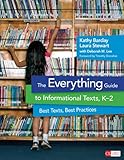The everything guide to informational texts, K-2 : best texts, best practices / Kathy Barclay, Laura Stewart, with Deborah M. Lee.
Publisher: Thousand Oaks, Calif. : Corwin, [2014]Copyright date: © 2014Description: xv, 273 pages : illustrations ; 28 cmContent type:- text
- unmediated
- volume
- 9781452283104 (pbk.)
- 1452283109 (pbk.)
- spine title : The everything guide to informational texts, K-2
| Item type | Current library | Home library | Collection | Call number | Materials specified | Copy number | Status | Date due | Barcode | |
|---|---|---|---|---|---|---|---|---|---|---|
| AM | PERPUSTAKAAN TUN SERI LANANG | PERPUSTAKAAN TUN SERI LANANG KOLEKSI AM-P. TUN SERI LANANG (ARAS 5) | - | LB1576.B368 (Browse shelf(Opens below)) | 1 | Available | 00002142462 |
Includes bibliographical references : (p. 255-259) and index.
Machine generated contents note: ch. 1 New Standards, Timeless Goals: How Informational Texts Can Help Make Every Child a Reader -- A Crash Course on the Common Core -- The College and Career Readiness Anchor Standards for Reading -- Naming the Skills Involved in Reading Nonfiction and Fiction -- Where Do We Go From Here? -- ch. 2 Bringing Informational Texts Into Your Teaching -- Goal 1 Expose Children to More Complex Texts -- Goal 2 Pay More Attention to Oral Language -- Goal 3 Be More Intentional -- Goal 4 Differentiate Instruction -- Goal 5 Explicitly Teach From the Text -- ch. 3 The How-To's of Selecting Stellar Texts -- The New Nonfiction -- Evaluating Format and Visual Appeal -- Evaluating Accuracy and Authenticity -- Evaluating Writing Style and Appropriateness for Young Children -- Evaluating Potential Content and Curricular Connections -- ch. 4 The Top Ten: Focus on These High-Impact Comprehension Strategies.
Contents note continued: Teaching High-Impact Skills and Strategies for Comprehending Informational Text -- 1. Use prior knowledge -- 2. Make inferences (predict, determine cause and effect, draw and support conclusions) -- 3. Visualize information -- 4. Ask and answer questions -- 5.Compare and contrast text and pictures -- 6. Determine key ideas and details -- 7. Interpret information from graphs, charts, and diagrams -- 8. Use references and resources -- 9. Summarize and synthesize -- 10. Monitor comprehension and use fix-up tips -- ch. 5 Demystifying What Makes Lessons Effective: The Lesson Plan Template -- The Overarching Goal of Informational Text Lessons: Rigorous Text Experiences for All Students -- The Four Lesson Steps -- A Detailed Look at the Lesson Template -- Summary of the Lesson Plan Action Steps -- How the Template Addresses CCSS for Informational Text -- How the Template Helps You Model Text-Based Responses -- How the Template Addresses Foundational Skills.
Contents note continued: How the Template Addresses Interdisciplinary Learning -- ch. 6 Informational Text Read-Aloud Lessons in Kindergarten -- The Common Core Standards for Informational Text Read-Alouds -- Using the Lesson Plan Template for the Read-Aloud -- Step 1 Prepare to Read -- Step 2 Guide Reading -- Step 3 Explicitly Teach From the Text -- Step 4 Facilitate Connections -- Miss Webb's Kindergarten Class: A Sample Informational Text Read-Aloud Lesson -- Kindergarten Informational Text Standards Included -- ch. 7 Informational Text Lessons in First Grade -- What's Different About First Grade? -- Mrs. Stacker's First Graders: A Sample Informational Text Guided Reading Lesson -- First Grade Informational Text Standards Included -- Other Standards Addressed -- ch. 8 Informational Text Lessons in Second Grade -- What About Students Who Are Not Reading With Grade-Level Proficiency? -- Mr. Morris's Second Graders: A Model Informational Text Guided Reading Lesson.
Contents note continued: Second Grade Informational Text Standards Included -- Other Standards Addressed -- ch. 9 Embedding Informational Texts in Units of Study -- An Interdisciplinary Focus -- Planning Units of Study: Who Does What? -- Selecting High-Quality Informational Literature for Units of Study -- Characteristics of Narrative and Expository Text -- Concluding Thoughts -- APPENDIX A Checklist for Evaluating Informational Literature -- APPENDIX B Common Core State Standards (CCSS) Checklists -- Kindergarten CCSS Checklist -- First Grade CCSS Checklist -- Second Grade CCSS Checklist -- APPENDIX C Lesson Plan Template -- APPENDIX D Topical List of Informational Literature -- APPENDIX E Annotated Bibliography of Children's Books.
Many educators, overwhelmed by the increasing demands of the profession and by the effort that the move to the Common Core Standards requires, continue to view fiction text as the primary source for both read aloud experiences and beginning reading instruction. This text helps all educators and prospective educators see nonfiction texts as an important component of all aspects of the PreK-2 curriculum and to provide them with practical, proven tools for selection and use of a wide variety of informational literature, including books, magazines, charts, graphs, digital media, and more. The authors examine why a balance of informational and narrative text is so important, and what recent research reveals about the value of using nonfiction text with young children. Those working most closely with children in kindergarten through second grade classrooms will find this to be a practical resource for understanding the Standards related to nonfiction text, and for selecting and using appropriate informational literature to build young children's background knowledge and their acquisition of foundational reading skills.
Text in English.
There are no comments on this title.

